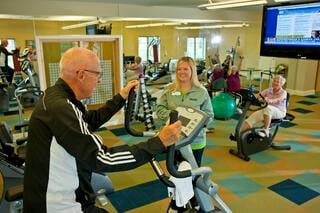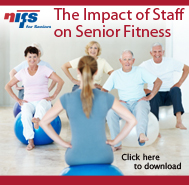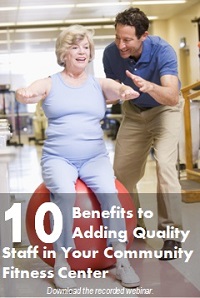 From the wellness consulting and fitness management work we’ve done with our clients over the last several years, we’ve seen our share of essentially empty fitness centers and pools in senior living communities.
From the wellness consulting and fitness management work we’ve done with our clients over the last several years, we’ve seen our share of essentially empty fitness centers and pools in senior living communities.
It’s sad.
So often, community leadership invests substantial capital dollars for dedicated fitness spaces including rooms that hold the exercise equipment, rooms devoted to group exercise classes, and additional (and typically significant) spaces for aquatics amenities. The result after construction is that the spaces are beautiful—even stunning.
But these same swanky spaces, unfortunately, often aren’t functional. Sometimes they contain the wrong equipment or a dysfunctional design. Most commonly, the biggest roadblock to a thriving fitness program is that these spaces weren’t considered under any type of strategic plan, so programming of the space is largely ineffective for the residents and typically disjointed from the rest of the community.
The result is a beautiful new space that sits unused.
If you’re wondering why you poured so much money into this non-revenue generating space that appears to provide no additional benefit to the residents, or how to avoid this phenomenon, stick with me on this blog series, where I’ll write about the following:
- Your capital investment isn’t the end of your commitment.
- Your residents need quality leadership in order to engage in the fitness services.
- Your marketing and sales team may be missing the mark when selling fitness to residents.
Part 1: Your Capital Investment Isn’t the End of Your Commitment
It’s a big deal: You spent a lot of time with your developers on crafting a new space (or overhauling an existing one) that will match your community’s appearance, and that you hope will be a welcome addition (or change) for your residents. It’s not cheap, either, but you’ve done your due diligence, secured the funds, and designed the heck out of the space(s).
The capital investment may be so substantial that it feels like enough.
Alas, your time and your money are, in fact, not enough. There are important details to consider regarding the design of the space—details that can make or break the overall function of the amenities. Read our blog on key things to avoid when you’re building a fitness center in senior living to find out more about common pitfalls when designing a new fitness space for senior living.
But you can’t stop with the physical space. This isn’t an “if you build it, they will come” type of project. You will need to cultivate a strategic plan for effective use of the space after it’s open for use.
Maybe that strategy is the job of the activities director.
Or maybe…the community needs a whole new approach to resident wellness that puts a wellness director at the top of the activities food chain. I’ve said it before, but it bears repeating: Wellness is a way of life, not an activity, and it should be cultivated accordingly. Do the activities drive the wellness program in your community, or does the wellness culture dictate the activities? Answering that question according to the organization you are striving to be will help you figure out the hierarchy question.
Regardless of who is in charge of it, the strategy for effective use of the fitness center is really central to ensuring that this new space contributes positively to residents’ vitality. Questions for cultivating the strategy should include the following:
- What is the goal, mission statement, or focus of wellness in the community, and in what ways do you expect that your fitness program will contribute to that end?
- What investment needs to be made in staffing for the fitness center? (The answer to this question varies by community, but I can just about guarantee you that fee-based personal trainers and group fitness instructors are not enough.)
- How will you know you’re achieving success in your programs? Will you mark it with simple participation goals, or will you be reviewing health outcomes, satisfaction, or other outcomes in your programming?
- If you’re changing your activities/wellness hierarchy, how will you communicate those changes to the community and how will you reinforce your emphasis on this culture shift? Will that information need to be communicated to the residents? If so, how will you do that?
- What operating decisions need to be scrutinized in light of your new emphasis on resident wellness? Does it make sense for your organization to make this strategic shift by including wellness for your employees at the same time?
To be sure, these questions, when thoughtfully addressed, will likely lead to more questions. Be patient; cultivating a strategy takes time and often requires continuous tweaking. It is a journey well worth taking, both for the benefit of your business and for fulfilling you commitment to facilitate a vibrant lifestyle for your residents.
In part 2 of this blog series, I’ll write about the importance of the right leadership in your fitness program. Make sure you have subscribed to our blog so you don’t miss a beat on this series and other hot topics we’re covering.


 At NIFS, we work in both
At NIFS, we work in both  Unless you live under a really, really big rock, you have no doubt heard about the importance of robust wellness opportunities as central to a successful senior living community. There have been some fabulous profiles lately on organizations that are doing an amazing job of connecting their residents and others in the surrounding areas to opportunities to live well. Two recent examples highlighted by
Unless you live under a really, really big rock, you have no doubt heard about the importance of robust wellness opportunities as central to a successful senior living community. There have been some fabulous profiles lately on organizations that are doing an amazing job of connecting their residents and others in the surrounding areas to opportunities to live well. Two recent examples highlighted by 
 You're senior living community is missing out on some important benefits if you don't have detailed data from your fitness program. Read on to find out what you stand to gain by getting smarter about gathering and using data from resident participation in the fitness center and group exercise classes as well as evaluating resident participation in fitness center appointments and services.
You're senior living community is missing out on some important benefits if you don't have detailed data from your fitness program. Read on to find out what you stand to gain by getting smarter about gathering and using data from resident participation in the fitness center and group exercise classes as well as evaluating resident participation in fitness center appointments and services.
 Part 2: Eight Strategies to Bring About Successful Collaboration
Part 2: Eight Strategies to Bring About Successful Collaboration
 Part 1: Who Should Be Contributing to Resident Wellness?
Part 1: Who Should Be Contributing to Resident Wellness? If you have residents who want to use the fitness center at your community but aren’t sure how to get started safely, you may have given some thought to adding a fitness center manager who can provide that individual attention for your residents. Perhaps you’re unsure about where to start looking for your fitness center manager and what types of things they should be doing while they’re on the job. Read on to learn about four key job responsibilities we think your fitness center manager should be executing often and well.
If you have residents who want to use the fitness center at your community but aren’t sure how to get started safely, you may have given some thought to adding a fitness center manager who can provide that individual attention for your residents. Perhaps you’re unsure about where to start looking for your fitness center manager and what types of things they should be doing while they’re on the job. Read on to learn about four key job responsibilities we think your fitness center manager should be executing often and well.
 NIFS was thrilled to begin fitness management services at two new retirement community client sites in April. Furthermore, we were honored to be able to tailor our staffing services for the unique needs of each location. Community fitness and wellness programs can’t be addressed with a cookie-cutter approach. Read on to learn how NIFS is supporting the unique needs of each location and their residents.
NIFS was thrilled to begin fitness management services at two new retirement community client sites in April. Furthermore, we were honored to be able to tailor our staffing services for the unique needs of each location. Community fitness and wellness programs can’t be addressed with a cookie-cutter approach. Read on to learn how NIFS is supporting the unique needs of each location and their residents.